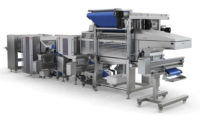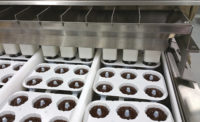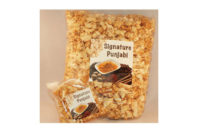Round loaves of sourdough bread, perfectly formed peanut butter cookies, mousse-filled tartlets … these are just some of the many products bakers craft using depositors, dividers or rounders. They also rely on these tools to create new items that meet consumer trends, to generate more units as sales increase, to help reduce production waste and more.
Flexible multitaskers
“Higher yield and quicker changeover due to greater uptime is a big driver for customers,” says Lance Aasness, executive vice president, Hinds-Bock Corp., Bothell, WA, which offers piston and servo depositing and filling equipment and systems. Hinds-Bock servo depositors accomplish this, he explains, through a recipe-driven operator interface. Operators choose a desired recipe or product name, and the depositor automatically selects the deposit parameters for that product. He notes that because operators don’t have to make multiple manual depositor adjustments, they can produce sellable product more quickly.
Hinds-Bock industrial muffin, cake and cupcake batter depositing lines are available with servo-driven depositors. The company began manufacturing servo-driven depositors 12 years ago for its food manufacturing customers, says Aasness. “This technology has been embraced by baking customers, because servo depositors are fast, quiet and achieve a lower utility cost since they use substantially less compressed air.” They also can be cleaned in place or disassembled in minutes without tools, facilitating sanitation.
Aasness notes that his company’s servo depositors address numerous other concerns. They feature interlocked, stainless steel safety covers that protect users, as well as give them the visibility they need to operate the depositor. The muffin and cupcake lines run more 1,300 pieces per minute, allowing for high-speed production. Lines are designed and manufactured for flavor and pan changeover through servo/programmable logic controllers and tool-free change spout spools.
Neil Anderson, director of business development, Axis Automation LLC, Hartland, WI, also cites flexibility, high-speed production and sanitation as top concerns for bakers when selecting a depositor. The Comas Model DV3 extruder can deposit two colors of dough simultaneously and apply a filling in the center, all at high capacity A variety of available options allow a single machine to create a selection of attractive products.
“Flexibility and the need for quick changeovers on certain product lines are changing the way our systems are designed,” says Anderson. “Product tooling can now be changed without the use of hand tools, and a common design can accept a variety of tools and attachments to allow the customer to produce variable product types.” He notes that designing equipment with sanitation in mind allows for quick and easy cleaning between changeovers.
Unifiller Systems, Delta, British Columbia, offers bakery equipment designed to help customers meet increasing industry sanitation levels and machine-safety standards and certifications, says Stewart Macpherson, vice president, sales and marketing for the company. He notes, however, that the three most significant benefits its customers realize when using the depositing solutions are precise portion control, which reduces ingredient costs and waste; high-speed depositing, which increases productivity and reduces labor costs; and product consistency, which contributes to customer satisfaction and repeat orders.
Macpherson notes that one of the company’s latest innovations is a fully computer-controlled, volumetric depositing solution that incorporates speed, volume, flow pattern, deposit delay and cut-off into recipes on its touchscreen. One machine using this new technology is the MultiStation, a high-speed, multiport metering system and depositor available in six- and eight-across configurations. “We believe this machine could well be the fastest multiport depositing machine on the market today,” he says. “It can fill a ½-ounce deposit at speeds of up to 125 rows per minute. Eight across would equate to around 1,000 portions per minute.”
The depositors also enable bakers to respond to consumer trends with new, value-added products, notes Macpherson. “Bakers today continue to produce new products of a higher quality than ever before, such as muffin or cake batters containing larger fruit, nut or chocolate inclusions. This means that accurately portioning bakery products with depositors without changing the integrity of the formula is key.”
John McIsaac, vice president, strategic business development, Reiser, Canton, MA, says numerous issues are important to customers purchasing a depositor or divider, but versatility, speed and payback are the requirements they “hone in on.” Among the company’s equipment offerings are Vemag dough dividers, depositors, extruders and coextrusion systems.
“When people look to Vemag for their depositing and dividing needs, the first thing they talk about is scaling or weight accuracy of the deposit,” McIsaac says. He notes that accurate scaling allows customers to see that “the machine will pay for itself over a short period of time, especially in high-speed production, where our machines have the highest outputs on the market. Smaller producers may zero-in on weight accuracy and versatility.” Attachments allow manufacturers to adjust their product mix and maintain their investment in their machinery, he says.
McIsaac notes that today’s dividers and portioners are more advanced than those available 10 years ago due to excellent competition in the field. “At Reiser, we focus on the divider as the key piece of equipment in the line,” he explains. “The divider is where money is made or lost. This is why it is often referred to as ‘the cash register.’”
McIsaac says his company has focused “tremendous amounts” of resources to follow a product from the mixer to the hopper and onto the belt. “At each point in the machine, we have analyzed the flow and improved its ability to scale accurately,” he explains. “Perhaps more important have been the advances we have made to doing this, while gently handling the product. Our dividers have advanced to the point where we consider them continuous pocket dividers, rather than extrusion dividers.”
Meeting needs
Ken Johnson, president, Gemini Bakery Equipment Co., Philadelphia, says that bakers take multiple factors into account—noise, sanitation, changeover, worker safety, speed, cost and so on—when buying a divider/rounder. “All of these issues are important,” he acknowledges. “However, the most-important consideration for our customers is to have one machine that allows them to produce the widest variety of products possible and also gives them future product mix flexibility.”
To that end, Gemini designs its divider/rounders around interchangeable dividing heads and rounding drums, and they can be quickly converted to accommodate a wide range of products.
Johnson says these features, combined with an independently driven, adjustable and configurable spreader belt, offers customers maximum product flexibility. “Water-friendly” versions are also available.
Johnson notes that the Gemini/W&P Tewimat divider/rounder, which was introduced more than 30 years ago, keeps evolving to meet bakers’ needs for wider weight range and higher speed flexibility. The smaller Tewimat TW-L comes in a one- to six-pocket configuration, while the larger Tewimat TW-S is available in a one- to 12-pocket configuration. Weights range from 0.75 to 22 ounces, depending on pocket configuration and machine speeds.
Introduced in fall 2013, the Koenig Rex Multi Futura, an automatic dough divider/divider available from Koenig Bakery Systems, Ashland, VA, addresses several considerations important to bakers, including high product flexibility, optimized weight accuracy, improved sanitation and tool-free maintenance.
According to the company, the unit offers a weight range of 0.6 to 8.1 ounces for rounded dough pieces and up to 21.1 ounces for divided-only dough pieces, enabling manufacturers to create a wide variety of products, from rounded dinner rolls to pan bread. The machine has an hourly output rate of up to 9,000 pieces in a six-row operation, and up to 1,500 pieces in one-row operation.
The Koenig Rex Multi Futura is just one of several divider/rounder models in Koenig’s Rex, Mini Rex and Industrie Rex programs. The programs feature models for production needs ranging from 3,600 pieces per hour to 42,000 pieces per hour. Special stamping tools enable manufacturers to extend their product variety, while easily accessible and removable components facilitate maintenance and cleaning.
WP Winkler, a division and brand in the WP Bakery Group USA, Shelton, CT, the North American subsidiary for The WP Bakery Group of Germany, recently introduced the WP Winkler WBD 100 bagel divider, a unit that delivers weight accuracy and speed. “We have been able to design a bagel divider that can run at 100 strokes per minute with a weight accuracy of ±1 gram,” says Jay Moynihan, technical director, WP Bakery Group USA. “This is done by the way we bring the dough into the divider and a drum that rotates completely to increase the speed.” He adds that the most important process point with the new divider is that the mixing area must be able to keep up with the intense speed.
WP Kemper, another division and brand of WP Bakery Group USA, offers a divider for softer doughs called the SoftStar. “The type of dough used and the final product required are the most-important factors when selecting a divider/rounder in an industrial bakery,” says Ken Weekes, roll line specialist for the company. “If these factors are not correctly interpreted, they can result in inaccurate weights, bad round moulding or—at worst—sticking in the machine. A badly divided and moulded product at the start of the process cannot be corrected later, and will result in a bad product at the end of the process, which increases the rejected products at quality control and unsatisfied customers.”
Weekes says recent improvements to enhance flexibility and durability included replacing mild steel dough chambers with stainless steel dough chambers; using plastic hoppers instead of stainless steel hoppers (to eliminate the need for Teflon); using blue plastic components instead of white plastic components (for improved hygiene and visibility); replacing the felt spreading belts with Intralox belts (for easier cleanability and no moisture absorption); and using servo drives for the main ram instead of hydraulic drives.
Changing consumer tastes will continue to determine the types of products bakers bring to market, as well as the features they’ll look for in a new depositor, divider or rounder—and the flexibility and versatility to change with the times will help keep manufacturers current.










